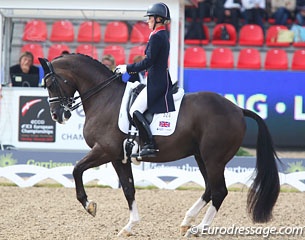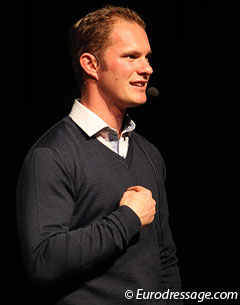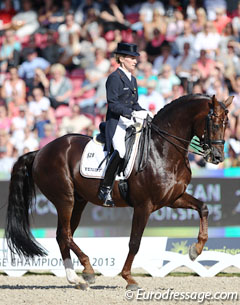
The piaffe is one of the most difficult aspects in the art of dressage, which is of course why it is not introduced until the final stages of dressage competition. There are so many delicate questions to consider when approaching the piaffe and the decision of how to ask is just one of many very personal elements that are unique to each horse and rider.
Nuno Oliveira used to say that the most important thing to remember in the piaffe is to never forget the principle, "position and let him do" (Placer et Laissez Faire), meaning that in asking the piaffe the rider should not be pushing every step, but create the "piaffe ready realm" in which the horse can piaffe alone with ease and confidence.
So, how do we know if we have all the elements ready to create that realm? When can we feel that our horse is ready to begin the piaffe learning? How do we know if we need to back off? And... when should we realise it's time to call in an expert?
Piaffe training expert from Australia, Tristan Tucker, runs a 14-horse barn in Holland and says more and more of his boxes are being filled with horses coming in for specialized piaffe training. "When to begin the piaffe with a young horse depends on the type of horse and if the horse has a certain weakness in this area we will start a little earlier," says Tristan. "If it is a horse with a natural talent for the piaffe then we may concentrate on other areas of weakness first. In the way we are training the piaffe from the ground there are no great demands on high levels of collection through lots of tempo changes to achieve the piaffe through a shortening of the trot or creating pressure for half steps from the walk. We have a simplified approach for the horse that gives them a simple break down of each of the fundamental steps that they can learn to perform the piaffe, because of this slow breakdown in hand from the ground it is not uncommon for us to start with the basic exercises with a 4-year old."
Normally commencing the piaffe work in hand, Tristan begins using only a rope halter with no saddle, making sure he maintains good body control and control over the feet of the horse, so the horse can stand by himself on the track. "This way we don't put extra pressure or mixed and distracting signals by trying to hold the horse where we want," said Tucker. "We then begin normally with a bamboo stick or something stiff with a lot of control, 'not a dressage whip'. We ask the horse to lift and hold his hind legs creating a clear path from point A to point B, with balance, the correct direction of the hind leg from relaxation, and a clear understanding from the horse what it is he is being asked to do."
 Sounds simple, no? However, the common mistake people make is to ask just that bit more, when the secret lies in the trainers ability to reward in the instant the horse shows effort. "Start with a clear realistic step by step plan of how you are going to train the movement and never go to the next step until the horse understands the When, How, and Why to perform the last. Never go the next step till you can do the previous one."
Sounds simple, no? However, the common mistake people make is to ask just that bit more, when the secret lies in the trainers ability to reward in the instant the horse shows effort. "Start with a clear realistic step by step plan of how you are going to train the movement and never go to the next step until the horse understands the When, How, and Why to perform the last. Never go the next step till you can do the previous one."
Asking for too much is only one of the mistakes that riders and trainers make when teaching piaffe and there are some fundamental questions that Tristan advises to always keep in mind. "You cannot let the horse take over and forget his ground rules. Ask if you are teaching or are you spending 50% of the time arguing? And always ask yourself, does the horse understand what I'm asking? If the horse does understand what you are asking, there are other elements to then keep in mind so you can maintain the horse's confidence, and willingness."
Nuno Oliveira said, "if necessary to create impulsion, touch the horse with the spur or the whip before to put him on the ball." This means don't bang and crash about during the piaffe, the horse must be set up, and allowed to piaffe without interference. In the execution of piaffe don't forget the principle, "position and let him do. (...) When he enters the piaffe, leave him in peace. So prepare and let him do it. What is needed is that the horse enters the piaffe with ease." And always remember, to keep the line: "From the beginning of piaffe training, the horse must be completely straight,"
Certain that piaffe can give balance, elasticity, strength, rhythm, confidence, and discipline to all other aspects of dressage training, Tristan warns that if piaffe is trained in the wrong way for that particular horse, it can also be the undoing of everything. "Of course there are horses that are built with more natural conformational elements for doing piaffe, horses that are naturally sharper have a higher work ethic, and horses with a better natural rhythm find it more easy to pick up," said Tucker. "Also, a hors with a shorter point of balance, will enable a greater angle of the hind leg, so the horse can sit more under the base of his body."
 Sadly, Tristan knows that there are many horses that will never do a piaffe in any one particular system of training, but the good news is, there are no horses with four legs that can not do piaffe. We just have to find the right key! "I never accept that a horse will not learn to do piaffe, if there was a stage similar to this, it would be the stage where I would have to accept that I did not have the way to teach that horse, not that the horse could not be taught," he stated. "In our training of piaffe we ask the when, how and why to do the piaffe so that the horses learn to offer it, and the rider is not forced to ride it out of him."
Sadly, Tristan knows that there are many horses that will never do a piaffe in any one particular system of training, but the good news is, there are no horses with four legs that can not do piaffe. We just have to find the right key! "I never accept that a horse will not learn to do piaffe, if there was a stage similar to this, it would be the stage where I would have to accept that I did not have the way to teach that horse, not that the horse could not be taught," he stated. "In our training of piaffe we ask the when, how and why to do the piaffe so that the horses learn to offer it, and the rider is not forced to ride it out of him."
Well known dressage trainer Jan Bemelmans usually starts the piaffe training from 5 years, depending from horse to horse. "The best is to start from the ground and I do this mostly with the rider on top," said Bemelmans.
From there, determining when to ask more and when to back off is very individual and depends entirely on the feeling and experience off the trainer. "The thing to avoid most for the horse is that it gets afraid of the new experience, and confidence between the trainer and the horse is super important," said Jan
Bemelmans' advice is to "go step by step" and let the horse make his own way into piaffe perfection. "Sometimes go just one round, win his confidence! The horse will show you what is possible."
by Sarah Warne for Eurodressage
Related Link
Sarah Warne's Classical Training Articles